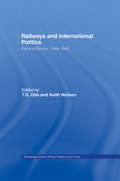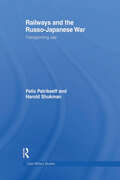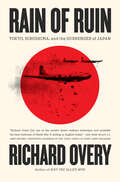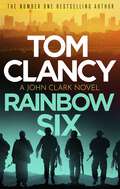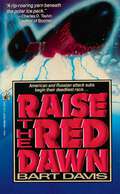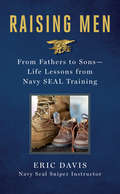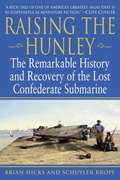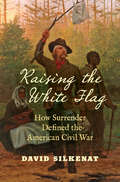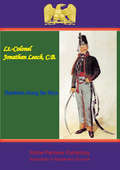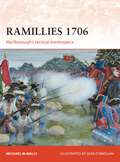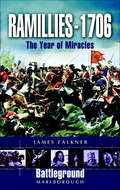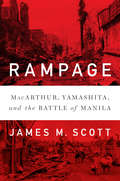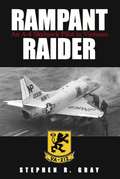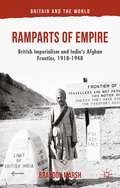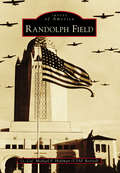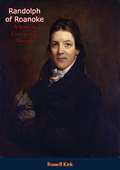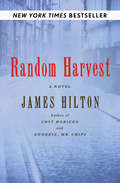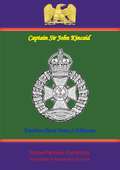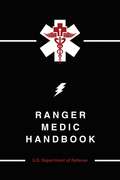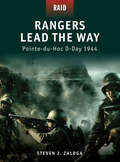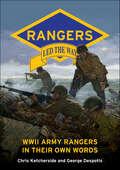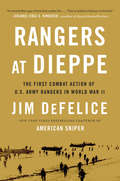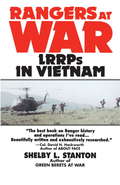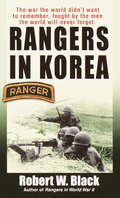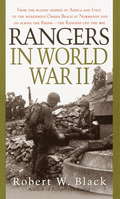- Table View
- List View
Railways and International Politics: Paths of Empire, 1848-1945 (Military History and Policy)
by T. G. Otte Keith NeilsonThis new study brings together leading experts to show how the modern world began with the coming of the railway. They clearly explain why it had a greater impact than any other technical or industrial innovation before and completely redefined the limits of the civilized world. While the effect of railways on economic development is self-evident, little attention has been paid to their impact on international relations. This is unfortunate, for in the period from 1848 to 1945, railways were an important element in the struggle between the Great Powers. This took many forms. Often, as in East Asia, the competition for railway concessions reflected the clash of rival imperial interests. The success or failure of this competition could determine which of the European Powers was to dominate and exploit the markets of China and Siam. Just as often, railways were linked with military matters. Prussia’s success in the wars of German unification depended on its strategic railways just as much as on the strength of its armies, and the rail links remained a vital aspect of German military thinking before the First World War. So, too, did they for the Russians, whose vast Empire required rail links capable of moving the Tsarist army quickly and competently. Just as importantly, railways could be vital for Imperial defence, as the British discovered on the North-West frontier of India. This book will be of much interest to students of international history, military history and strategic studies.
Railways and the Russo-Japanese War: Transporting War (Cass Military Studies)
by Felix Patrikeeff Harry ShukmanThis book explores the nexus between railways and the Russo-Japanese War (1904-05) - the first modern war, and one in which the railways played a key part.Felix Patrikeeff and Harry Shukman examine some of the key dimensions of the Russo-Japanese War, most notably how uncomfortably technological and human dimensions of Russia‘s war effort interleav
Rain of Ruin: Tokyo, Hiroshima, and the Surrender of Japan
by Richard OveryA leading historian of World War II sheds new light on the purposes and impact of the U.S. incendiary and atomic bombing of Japan’s cities in 1945. With the development of the B-29 “Superfortress” in summer 1944, strategic bombing, a central component of the Allied war effort against Germany, arrived in the Pacific theater. In 1945 Japan experienced the three most deadly bombing attacks of the war. The firebombing of Tokyo in March burned the city’s most densely populated sector, killed some 85,000 residents, and left more than one million homeless. The attack was part of a months-long campaign of incendiary bombing that destroyed almost two-thirds of Japan’s cities. The two atomic blasts in August killed hundreds of thousands in Hiroshima and Nagasaki, most of them civilians. The bombing brought a destabilizing devastation that, combined with a declaration of war by the Soviet Union, induced Japan, as they put it, to terminate the war. Many at the time and since have credited American air power, and especially the two atomic bombs, with Japan’s surrender. But Richard Overy tells a different, more dimensional story. Drawing on his expertise on the war and its bombing campaigns, he delivers a precise recounting of these aerial attacks, and a balanced, informed assessment of how and why they occurred. Overy is astute on the Allied decision-making, and, notably, integrates the Japanese leadership as well. He ably navigates the dramatic endgame of the war, which featured factional infighting within the Japanese cabinet, a scramble by American officials to formulate an acceptable version of “unconditional surrender,” and the crucial role played by the emperor, Hirohito. The atomic bombing emerges as impactful but not decisive in this rich, multilayered history
Rainbow Six: The unputdownable thriller that inspired one of the most popular videogames ever created (John Clark #2)
by Tom ClancyTHE CLASSIC SECOND THRILLER IN TOM CLANCY'S INTERNATIONALLY BESTSELLING JOHN CLARK SERIES'Action-packed' New York TimesNewly named head of an elite multinational task force, John Clark faces the world's greatest fear: international terrorism. And following each terrifying new outbreak - the ghosts from his own past.The challenge of a new mission is just what Clark needs, but the opportunities come faster than he expected. Hostage-taking at a Swiss bank. The kidnapping of an international trader. Carnage at a theme park in Spain. Each incident seems separate, yet the timing disturbs Clark.Is there a connection? Is he being tested? Or is there a bigger threat out there, from terrorists so extreme that no government is ready to admit their existence?
Raise the Red Dawn
by Bart DavisWhen an aging Soviet submarine becomes caught under the polar ice cap while being escorted by one of the best submarines in the Soviet Navy, a high-tech game of cat and mouse involving the US ensues to see who can get to the submarine—and the dangerous propulsion system it’s carrying—first.
Raising Men: Lessons Navy SEALs Learned from Their Training and Taught to Their Sons
by Eric Davis Dina SantorelliAfter Eric Davis spent over 16 years in the military, including a decade in the SEAL Teams, his family was more than used to his absence on deployments and secret missions that could obscure his whereabouts for months at a time. Without a father figure in his own life since the age of fifteen, Eric was desperate to maintain the bonds he'd fought so hard to forge when his children were young--particularly with his son, Jason, because he knew how difficult it was to face the challenge of becoming a man on one's own. Unfortunately, Eric learned the hard way that Quality Time doesn't always show up in Quantity Time.Facebook, television, phones, video games, school, jobs, friends--they all got in the way of a real, meaningful father-son relationship. It was time to take action.As a SEAL, Eric learned to innovate and push boundaries, allowing him to function at levels beyond what was expected, comfortable, ordinary, and even imaginable, and he knew that as a father he needed to do the same with his son. Meeting extreme with extreme was the only answer.Using a unique blend of discipline, leadership, adventure, and grace, Eric and his SEAL brothers will teach you how to connect, and reconnect, with your sons and learn how to raise real men--the Navy SEAL way.
Raising the Hunley: The Remarkable History and Recovery of the Lost Confederate Submarine
by Brian Hicks Schuyler KropfOn February 17, 1864, after a legendary encounter with a Union battleship, the iron "fish-boat" vanished without a trace somewhere off the coast of South Carolina.
Raising the White Flag: How Surrender Defined the American Civil War (Civil War America)
by David SilkenatThe American Civil War began with a laying down of arms by Union troops at Fort Sumter, and it ended with a series of surrenders, most famously at Appomattox Courthouse. But in the intervening four years, both Union and Confederate forces surrendered en masse on scores of other occasions. Indeed, roughly one out of every four soldiers surrendered at some point during the conflict. In no other American war did surrender happen so frequently. David Silkenat here provides the first comprehensive study of Civil War surrender, focusing on the conflicting social, political, and cultural meanings of the action. Looking at the conflict from the perspective of men who surrendered, Silkenat creates new avenues to understand prisoners of war, fighting by Confederate guerillas, the role of southern Unionists, and the experiences of African American soldiers. The experience of surrender also sheds valuable light on the culture of honor, the experience of combat, and the laws of war.
Rambles Along the Styx
by Lt.-Colonel. Jonathan Leach C.B.This ebook is purpose built and is proof-read and re-type set from the original to provide an outstanding experience of reflowing text for an ebook reader. Lt.-Colonel Leach served with some distinction during the Peninsular War and Waterloo campaign with the 95th Rifles, leaving his excellent memoirs "Rough Sketches of the Life of an Old Soldier". This tome is set in the underworld, where old comrades of the Peninsular War meet to discuss various incidents, anecdotes and war-stories. As the Author points out in his introduction, the majority of the stories are absolutely true, and they have probably been rendered in this way to protect the identity of the real soldiers. An intriguing read. Title - Rambles Along the Styx Author -- Lt.-Colonel. Jonathan Leach C.B. (1784-1885) Text taken, whole and complete, from the edition published in 1847, London, by T. and W. Boone. Original - iv and 134 pages.
Ramillies 1706
by Michael Mcnally Seán Ó'BrógáinRamillies 1706 details one of the most important clashes in the War of the Spanish Succession, a battle that secure the Duke of Marlborough's place in history and helped determine the future of Europe.In 1706, as the War of Spanish Succession dragged on, France's Louis XIV was eager for peace, but he wanted it on his terms. Therefore, rather than standing on the defensive, French armies on all fronts swung over to the offensive. Marlborough decided to counter by launching a pre-emptive strike. The two sides met at Ramillies on May 23rd.Enjoying an almost parity in numbers the French took up position along a river line, anchoring each of their flanks on a marshy area, thereby surrendering the initiative to Marlborough, who proceeded to probe against both flanks. Using a series of deceptions and feints, Marlborough took advantage of a concealed re-entrant to reinforce his center which, at that time, was cannonading the French positions. Unaware of this, the French general Villeroi drastically weakened his center in order to reinforce the threatened sector. Seizing the opportunity, Marlborough launched an overwhelming attack on his own terms. In the wake of two massive cavalry mêlées, during one of which Marlborough was unhorsed and almost killed, the allied troops shattered the French, inflicting over 20,000 casualties--almost one third of the Franco-Hispano-Bavarian army--at a cost of less than 4,000 men, thus paving the way for allied forces to overturn the French position in Flanders, and in the process capturing several strategically important towns and cities including Brussels, Bruges, Louvain and Antwerp. In short, whilst Blenheim in 1704 had been a masterpiece of strategic maneuver that had wrong footed the Franco-Bavarian armies and removed the threat to Vienna, it was Marlborough's tactical intuition on the field of Ramillies that had led to perhaps his finest battlefield performance and paved the way for a campaign that would see much of Flanders come under Allied control.
Ramillies 1706: The Year of Miracles (Battleground Marlborough)
by James FalknerAn account of the pivotal victory for the Grand Alliance forces during the War of the Spanish Succession, from a leading authority on eighteenth-century warfare. On Sunday, May 23 1706, near the village of Ramillies in modern Belgium, the Anglo-Dutch army commanded by John Churchill, 1st Duke of Marlborough, inflicted a devastating defeat on the French army of the Duke de Villeroi. Marlborough&’s triumph on that day ranks alongside Blenheim as one of the great feats of his extraordinary military career. The French army was shattered physically and morally and, as a result, Marlborough&’s army overran almost all of the Spanish Netherlands in the next six weeks, and gained an unshakeable advantage over the armed might of Louis XIV&’s France during the long War of the Spanish Succession. In this expert guide to the battle and the battlefield, James Falkner offers a gripping and authoritative account of the campaign and the action, and he takes the reader across the battleground itself, relating the course of the fighting to the terrain as it can be viewed today.
Rampage: Macarthur, Yamashita, And The Battle Of Manila
by James M. Scott“Illuminating.… An eloquent testament to a doomed city and its people.” —The Wall Street Journal In early 1945, General Douglas MacArthur prepared to reclaim Manila, America’s Pearl of the Orient, which had been seized by the Japanese in 1942. Convinced the Japanese would abandon the city, he planned a victory parade down Dewey Boulevard—but the enemy had other plans. The Japanese were determined to fight to the death. The battle to liberate Manila resulted in the catastrophic destruction of the city and a rampage by Japanese forces that brutalized the civilian population, resulting in a massacre as horrific as the Rape of Nanking. Drawing from war-crimes testimony, after-action reports, and survivor interviews, Rampage recounts one of the most heartbreaking chapters of Pacific War history.
Rampant Raider
by Stephen GrayA member of Light Attack Squadron 212 s "Rampant Raiders," A-4 pilot Stephen R. Gray writes about his experiences flying combat sorties from the deck of an aircraft carrier during one of the most intense periods of aerial combat in U.S. history. From the perspective of a junior naval aviator, Gray reveals the lessons he learned first at the Naval Aviation Training Command and then in actual combat flying the Skyhawk from USS Bon Homme Richard in Vietnam.Training strengthens commitment, Gray points out, allowing ordinary men like him to fly dangerous missions. Readers will discover how circumstances created heroe--heroes who managed to overcome their personal fears for a greater cause--and how, despite the lack of public support for the war, the men remained committed to one another. The book addresses how men react to service during contentious political times to offer lessons relevant today.
Ramparts of Empire: British Imperialism and India's Afghan Frontier, 1918-1948 (Britain and the World)
by B. MarshThis cultural and political study examines British perceptions and policies on India's Afghan Frontier between 1918 and 1948 and the impact of these on the local Pashtun population, India as a whole, and the decline of British imperialism in South Asia.
Randolph Field (Images of America)
by Lt. Col. HoffmanOnce touted as the "West Point of the air" in the pre-Air Force Academy years, Randolph Field/Air Force Base is famous for its Spanish Colonial Revival architecture, its iconic Administration Building (nicknamed the "Taj Mahal"), and its rectangular layout. Allowed by the Army hierarchy to design its own installation from the ground up, the Army Air Corps hit a home run in design uniqueness and functionality. When the Corps of Engineers built the base, working from 1928 to 1931, it was its biggest project since the Panama Canal. Randolph has been a popular assignment location for Air Force members for over 80 years and is currently home to the 12th Flying Training Wing, the Air Education and Training Command Headquarters, and the Air Force Personnel Center. Thousands have passed through Randolph's gates as students and permanent personnel, and many have chosen to live in the San Antonio area after discharge or retirement. Carefully landscaped with trees and shrubbery from the very beginning, Randolph is the "showplace of the Air Force."
Randolph of Roanoke: A Study in Conservative Thought (Library Of Conservative Thought Ser.)
by Russell KirkJohn Randolph (1773-1833), known as John Randolph of Roanoke, was a planter and a Congressman from Virginia, serving in the House of Representatives at various times between 1799-1833, and the Senate from 1825-1827. He was also Minister to Russia under Andrew Jackson in 1830. After serving as President Thomas Jefferson’s spokesman in the House, he broke with the president in 1805 as a result of what he saw as the dilution of traditional Jeffersonian principles. Thereafter, Randolph proclaimed himself the leader of the “Old Republicans” or “Tertium Quids”, a wing of the Democratic-Republican Party who wanted to restrict the role of the federal government. Specifically, Randolph promoted the Principles of ‘98, which said that individual states could judge the constitutionality of central government laws and decrees, and could refuse to enforce laws deemed unconstitutional.Through the life and thought of Randolph of Roanoke, the progress of the southern mind is traced from 1776-1861, from the equalitarianism of Jefferson to the defiant conservatism of Calhoun.
Random Harvest: A Novel
by James HiltonA World War I veteran&’s comfortable life is upended by buried memories in this &“completely real and convincing&” New York Times bestseller by an Academy Award–winning screenwriter (The New York Times). Charles Rainier&’s family feared him lost along with so many of Britain&’s youth during the Great War. But two years after he was reported missing in action, he appears in a Liverpool hospital with no memory of the time that has passed. Rainier marries and embarks on a life of relative success, but he still can&’t recall his time on the battlefield—until the first bombs of the Second World War begin to fall. Suddenly, his memories flood back. Now, recollections of a violent battlefield, a German prison, and a passionate affair all threaten to fracture the peaceful life he has worked so hard to create. From the bestselling author of Lost Horizon and Goodbye, Mr. Chips—who also earned an Oscar for his screenwriting during Hollywood&’s Golden Age—Random Harvest is a moving account of the trauma of war, the disruption of a seemingly ordinary life, and the courage required to find redemption in the face of the most overwhelming circumstances.
Random Shots From A Rifleman: Adventures In The Rifle Brigade And Random Shots From A Rifleman
by Pickle Partners Publishing Captain Sir John KincaidThis ebook is purpose built and is proof-read and re-type set from the original to provide an outstanding experience of reflowing text for an ebook reader. Sir John Kincaid served in the 95th Rifles, later the famed Rifle Brigade, throughout the Peninsular War and during the Belgian Campaign. This book is a follow-up to "Adventures in the Rifle Brigade", whose success spurred the author into publishing a second tome of recollections. His style is witty, pithy and framed with a long and hard fought insight into the warfare of the period. His reminiscences embrace the famed leaders of the period; such as Wellington, Craufurd, Sidney Beckwith et al. as well as the common soldiers that he fought with each day. Highly recommended
Ranger Medic Handbook
by U.S. Department of DefenseHistorically in warfare, the majority of all combat deaths have occurred prior to a casualty ever receiving advanced trauma management. The execution of the Ranger mission profile in the Global War on Terrorism and our legacy tasks undoubtedly will increase the number of lethal wounds. Ranger leaders can significantly reduce the number of Rangers who die of wounds sustained in combat by simply targeting optimal medical capability in close proximity to the point of wounding. Directing casualty response management and evacuation is a Ranger leader task; ensuring technical medical competence is a Ranger Medic task. A solid foundation has been built for Ranger leaders and medics to be successful in managing casualties in a combat environment. The true success of the Ranger Medical Team will be defined by its ability to complete the mission and greatly reduce preventable combat death. Rangers value honor and reputation more than their lives, and as such will attempt to lay down their own lives in defense of their comrades. The Ranger Medic will do no less.
Rangers Lead the Way: Pointe-du-Hoc D-Day 1944
by Steven Zaloga Howard GerrardIn the early hours of D-Day, 1944, a group from the US Army 2nd Rangers Battalion were sent on one of the legendary raids of World War II. The mission was to scale the cliffs overlooking Omaha beach and assault the German coastal artillery at Pointe-du-Hoc. It was thought that only a raid could ensure that the guns would remain silent during the D-Day landings. But allied intelligence was wrong.After climbing the cliffs under aggressive German fire and securing the battery site, the Rangers discovered that the guns themselves were no longer there. It was only due to the heroic actions of the Rangers involved that the guns were located in firing positions facing Utah beach and destroyed before they could be used. In the first of a brand new series for Osprey, this act of audacious daring is brought to life, complete with illustrated artwork, maps and rare German accounts. Taking a more critical look at the story, Steven Zaloga analyses every detail, from the intelligence failings to the boldness of the Rangers' in the face of such odds.
Rangers Led the Way: WWII Army Rangers in Their Own Words
by Chris Ketcherside George DespotisInterviews with 20 WWII 1st, 2nd, 3rd, 4th, and 5th Battalion Rangers
Rangers at Dieppe
by Jim DefeliceAfter Pearl Harbor, the United States was struggling to bring itself up to fighting strength for World War II when a specially-trained force-based upon the famed British commando squads-was formed. It would become known as the Rangers. Before their training was complete, the Rangers were thrust into battle, taking part in an assault on the German-held French port of Dieppe. Plagued by politics and inter-service rivalry, the raid would become one of the greatest debacles of the war. Allied losses included several Rangers killed or wounded-the first American blood spilled on European soil in the war. Here, drawn from historical records and personal recollections by those who were there, and illustrated with photographs, is the story of the baptism of fire of what would become the U.S. Army Rangers.
Rangers at War
by Shelby L. Stanton"Shelby Stanton has emerged as the leading military historian on the war in Southest Asia."COL. CHARLES B. MacDONALDAuthor of COMPANY COMMANDER and A TIME FOR TRUMPETSOne of the toughest and most challenging jobs in Vietnam was to be a U.S. Army Ranger running Long Range Reconnaissance Patrols. The LRRPs took volunteers only, and training was designed to weed out all but the best. What emerged was an elite outfit of warriors in the finest sense of the word. Now Shelby Stanton, renowned military authority on the war in Southeast Asia, presents the first and only definitive history of the LRRPs and the U.S. Army Rangers in Vietnam. They're all here: the Screaming Eagle Patrollers, Cochise Raiders, Charlie Rangers, Cobra Lightning Patrollers, and more.From the Paperback edition.
Rangers in Korea: The War the World Didn't Want to Remember, Fought by the Men the World Will Never Forget
by Robert W. BlackA generation before Vietnam, the war for Korea raged. It was as rough and dirty a war as has ever been fought--a war small in history, but very large to the men who waged it. . . . In the Korean War, one group above all others distinguished itself, a small elite band who volunteered for action behind enemy lines. They were the men of the U. S. Army's legendary Rangers. They succeeded in making the first combat jump in Ranger history, destroying enemy headquarters, and inflicting the first defeat on Communist Chinese forces while suffering a disproportionate number of casualties. This is their story, told here for the first time--based on military records, interviews with survivors, and the author's personal experiences as an American Ranger in the Korean War.
Rangers in World War II: Darby's Rangers In World War Ii
by Robert W. BlackFrom the deadly shores of North Africa to the invasion of Sicily to the fierce jungle hell of the Pacific, the contribution of the World War II Ranger Battalions far outweighed their numbers. They were ordinary men on an extraordinary mission, experiencing the full measure of the fear, exhaustion, and heroism of combat in nearly every major invasion of the war. Whether spearheading a landing force or scouting deep behind enemy lines, these highly motivated, highly trained volunteers led the way for other soldiers -- they were Rangers.With first-person interviews, in-depth research, and a complete appendix naming every Ranger known to have served, author Robert Black, a Ranger himself, has made the battles of WWII come to life through the struggles of the men who fought to win the greatest war the world has ever seen.
